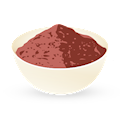Best Eastern Malaysian Foods
MAIN INGREDIENTS
Closely related to other laksa varieties, Sarawak laksa is characterized by a subtle, mild flavor. Consisting of a flavorful chicken or shrimp-based broth that is seasoned with thick laksa paste, which sometimes includes more than twenty different ingredients, the soup is accompanied by vermicelli noodles, shredded omelet, cooked prawns, and shredded chicken.
Spicy sambal and lime are traditionally served on the side. The origin of Sarawak laksa is still unclear, but it is believed that the dish appeared when Goh Lik Teck began to offer his noodle dish along Kuching’s Carpenter Street in 1945. According to popular belief, the thick paste used in the dish was popularized by the Tan family from Kuching, somewhere between the 1960s and 1970s.
OTHER VARIATIONS OF Laksa
MOST ICONIC Sarawak laksa
View moreKolo mee is a traditional dish hailing from Sarawak. This simple dish consists of egg noodles that are tossed in sauce and topped or served with sliced barbecued pork (char siu), minced pork, and fried onions. In hawker stalls, the dish is often made with lard.
Kolo mee can be additionally enriched with fish balls, wontons, and vegetables such as choy sum (a leafy vegetable). It's believed that the dish was created under the influence of Chinese cuisine, and today it's served for breakfast, lunch, and dinner in Sarawak, especially in Kuching.
Translated as ring cakes, this traditional Malay kuih is usually associated with the Brunei Malay community in Sabah. They are prepared with rice flour and a combination of red palm sugar (niham) and coconut-based melaka sugar.
Usually shaped into floral forms, the cookies are dipped in rice flour batter, then fried twice to achieve their typical crispy texture. They can be enjoyed as a dessert or a snack.
MAIN INGREDIENTS
Ambuyat is the extremely sticky national dish of Brunei, made with sago palm tree starch that gets cooked into a substance similar to glue. It is typically eaten for lunch with a fermented sour sauce and a variety of vegetables on the side. Ambuyat is traditionally prepared for special occasions where it serves as a substitute for rice.
Locals eat it with a double pronged bamboo stick known as chandas and the best way to eat Ambuyat is by twirling it around the stick, then dipping it into a sauce and swallowing it instead of chewing. Ambuyat may be accompanied by a variety of side dishes, dips, and sauces due to its blandness (a minimum of three main and side dishes), and some say it tastes like "nothing at all." The most popular dips are binjai, made from a local sour fruit, and tempoyak, made with the (in)famous durian fruit.
MAIN INGREDIENTS
Kelupis is a traditional snack of both the Bisaya people and the Bruneian Malay people residing in Brunei and the Malaysian states of Sabah and Sarawak. Glutinous rice is first cooked in coconut milk that is flavored with pandan leaves, then wrapped in daun nyirik leaves.
The prepared rolls are steamed, then left to hang so they contain no excess water and the rice inside is not wet or damp. Once unwrapped, this snack is delicious enough to be eaten alone, but it's typically paired with curry or a spicy meat dish known as rendang.
Tuaran mee is a traditional noodle dish originating from Tuaran, hence the name. This fried noodle dish is made with golden Tuaran egg noodles and consists of eggs, char siu, choy sum, pork egg rolls, and of course, egg noodles. If properly prepared, a plate of fried Tuaran mee should be aromatic, eggy, and slightly smoky as a result of charring in the hot wok.
Additional protein such as beef, chicken, pork, or seafood is often added on top of the dish, and once served, it’s recommended to accompany it with sambal chili sauce on the side.
MAIN INGREDIENTS
Tebaloi is a traditional snack originating from Sarawak. It's usually made with a combination of sago flour, eggs, desiccated coconut, turmeric, sugar, and various flavorings. The dough consists of sago flour, coconut, sugar, and eggs. It's flattened on a large banana leaf and placed over hot embers.
The dough is then removed, cut into squares, and placed back on the embers. A heavy block is placed on top of the crackers to flatten them even more. The smoke from the wood gives a unique aroma to these crackers. Over time, tebaloi has been enriched with different flavors such as pandan or chocolate.
MAIN INGREDIENTS
Nasi kombos is a traditional rice dish originating from the Lotud community in Sabah. The dish is made with a combination of glutinous rice, coconut cream and water, salt, and grated coconut flesh. The glutinous rice is cooked in coconut water.
Once cooked, the rice is mixed with grated coconut flesh and the mixture is seasoned with salt to taste. Nasi kombos is traditionally served in a coconut shell and enjoyed warm.
Best Eastern Malaysian Food Producers
AWARDS

Academy of Chocolate - Silver
2022, 2020

Academy of Chocolate - Bronze
2020
BEST Jaws & Claws Chocolate Chocolates
Best Eastern Malaysian Food Products
AWARDS

Academy of Chocolate - Silver
2020
AWARDS

Academy of Chocolate - Silver
2022
AWARDS

Academy of Chocolate - Bronze
2020
AWARDS

Academy of Chocolate - Bronze
2020
AWARDS

Academy of Chocolate - Silver
2020
AWARDS

Academy of Chocolate - Silver
2020
AWARDS

Academy of Chocolate - Silver
2020
TasteAtlas food rankings are based on the ratings of the TasteAtlas audience, with a series of mechanisms that recognize real users and that ignore bot, nationalist or local patriotic ratings, and give additional value to the ratings of users that the system recognizes as knowledgeable. TasteAtlas Rankings should not be seen as the final global conclusion about food. Their purpose is to promote excellent local foods, instill pride in traditional dishes, and arouse curiosity about dishes you haven’t tried.









